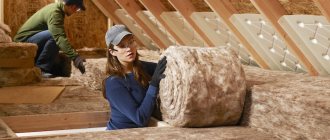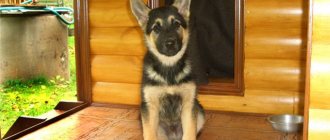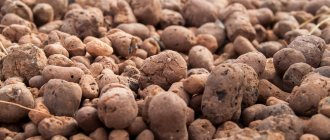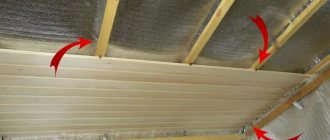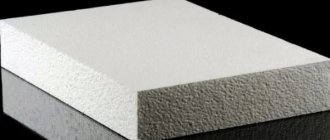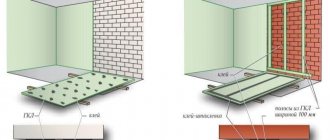Chickens are heat-loving people and rather flimsy. Winter, especially in cold regions, always becomes a serious test for them, and if the chicken coop is not properly insulated, wintering becomes especially difficult. Ice water in the drinking bowl, drafts, constant darkness - you should not expect either eggs or good health from birds that live in such harsh conditions.
Kansei
In the village, our chickens lived in a plank shed, without any insulation; the temperature there was slightly higher than outside. The chickens did not freeze, although the rooster's comb sometimes froze. The downside is that under such conditions, chickens almost never lay eggs in winter, and if they lay eggs and you didn’t keep track, the eggs freeze and burst.
In this article we will tell you how FORUMHOUSE members insulate their poultry houses for the winter.
Shingles
Another way to insulate walls is to use two layers of tiles, which are nailed at an angle of 45 cm. After the masonry is completed, the walls are plastered with clay mixed with sawdust. The solution should have a uniform consistency and harden over time. A minimum layer thickness of 3 cm is used.
When the walls are dry, they may crack - such cracks are filled with a mixture of clay and fine sand in a ratio of 1: 2. Finally, the walls are whitened with quicklime. The whitewashed walls are lined with plastic to prevent chickens from pecking at the plaster.
High heat losses occur not only from the floor, but also from poorly insulated windows. In general, 1-2 small windows are enough, which are best not installed on the north side. In cold weather they should be covered with plastic wrap. The chicken coop door is another conductor of cold. It should be located on the south side and should be insulated with old carpets or foil. If possible, you can also put old carpets and felt on the floor.
Are chickens afraid of frost and can they winter in a greenhouse?
Important! At sub-zero levels, the productivity of chickens will drop sharply, but they will not die and will be able to survive.
If the birds have been acclimatized to the surrounding conditions, then the lowest temperature they can tolerate is – +7 °C.
In this case, the chicken coop should be well ventilated and free of drafts. Some summer residents use a greenhouse as a home for chickens. This is the most suitable place for birds, where they will receive enough light and be able to rummage in the ground all day.
Heaters
In winter, for insulation, simply plug the plug into the socket.
Heating - diesel fuel furnaces. These models do not smoke and are fireproof. For example, to heat a room of 100 m2, you will need a stove with a 2.5 liter storage tank. — One run is enough for 12 hours at -20 ° C.
Heaters are also popular - they run on solid fuel and can even heat several rooms at the same time. Electric heaters are more often used, but they and all electrical wiring must be installed out of the reach of birds - in a special fence or in a niche in the floor.
An economical heating option for winter and autumn is an infrared heater with temperature control, which allows you to save energy. Screen mesh lamps are the easiest way. The power of the light bulbs is adapted to the room.
What temperature should the chicken coop be in winter?
Maintaining the temperature inside the building at the same level throughout the winter will allow the hens to lay eggs well all year round.
The most comfortable mode is the temperature in the range – from +10 to +15 0С, but not less than +5
Suitable temperature parameters:
- With the arrival of spring, the egg production of laying hens increases by 40%. To create a spring microclimate in the chicken coop, the temperature is maintained at +18 °C.
- The temperature level in the poultry house should not drop below +10 °C , since as the weather gets colder the birds try to warm up and begin to consume a lot of feed. And most of the nutrients are spent on heating it.
- The most optimal temperature level is +12…+15 °C.
Lighting
Any chicken coop should have windows. And although heat escapes through them, it is impossible to do without them: to maintain a normal state, the bird needs sunlight. And to keep it warm, the frames are made with two or three glasses. And they must be sewn up with mesh from the inside, although it wouldn’t hurt from the outside, but not for the safety of the bird, but for its safety.
In order for chickens to continue laying eggs in winter, they need to extend the daylight hours: at least it should be 11-12 hours. That’s why they turn on the lighting for them. Here it is better to immediately install a controller that will turn the light on and off automatically. You'll spend more money, but you'll spend less time at the coop.
At first, some chickens will stay overnight on the floor (those that did not climb onto roosts and nests), but if the floor is warm, with sawdust, it’s okay. Gradually they will get used to it and by the time it is turned off they will sit still.
There is an option - make them wake up early and leave the evening natural. Then the light will be on in the morning, and in the evening, at dusk, they will go to bed according to the sun.
Read how to build a summer chicken coop with a run here.
We insulate the ceiling and roof
If a farmer breeds chickens all year round, then the building is built with an attic. This allows you to store bedding, food and much more there.
But drafts moving through the attic remove heat from the house. To retain heat, the roof must be insulated. Insulation and implementation techniques are chosen depending on the structure of the roof. As a rule, the upper part of the building is insulated with mineral wool or penoplex.
Step-by-step description of the process of insulating the roof and attic
Before you begin insulating the poultry house, it is necessary to remove the bad parts of the wooden coverings.
If the boards have areas damaged by rot or mold, these areas are replaced with new parts. Before installation, new boards are treated with an antiseptic.
Step by step description:
- It is customary to insulate the ceiling with mineral wool. It is laid on boards, covered with a vapor barrier film on top and secured on the underside of the frame boards with a construction stapler. For additional protection, a second layer of mineral wool is laid on top using the same principle.
- The entire structure is lined with clapboard. The material is fixed with metal clamps.
- To protect against parasites and rodents, the material is treated with special agents and then painted.
Preparatory activities
At the initial stage, the walls of the room are inspected; any cracks found must be repaired and rotten boards replaced with new elements.
Construction foam should not be used to repair cracks without an additional protective layer, since the material is destroyed under the influence of ultraviolet radiation.
In a wooden shed, it is necessary to consider attachment points for the internal sheathing of timber or metal profiles, which holds the protective layer and finishing.
Since installing thermal insulation does not guarantee maintaining the required temperature in winter, it is necessary to provide places for installing electric heaters.
The equipment is connected to an alternating current network; the wiring must withstand the load without overheating and destruction of the insulating layer. The power is supplied to a switchboard with automatic fuses (the rating is selected in accordance with the power of the connected heaters).
Required Tools
To carry out installation work you will need:
- measuring tool;
- a knife or hacksaw for cutting insulation and vapor barrier film;
- electric drill and cordless screwdriver;
- construction level (hydraulic or laser);
- Phillips screwdriver,
- electric jigsaw for cutting additional sheathing elements.
Some of the necessary tools for the job.
Insulation of windows and doors
The main part of the heat is evaporated from the chicken coop through the cracks in the window and door openings. Therefore, all holes are sealed with foam rubber, fabric, cotton wool and other available materials.
The insulated door should fit snugly against the walls to avoid drafts
To reduce heat loss, install one small window in the room, from which there will be enough lighting. The window is located on the south or east side. For more information about chicken coop lighting, read the article: about the features of the light regime for broiler chickens and egg-laying hens.
Insulation:
- Window. The window structure is equipped with two frames. In summer, the frame is removed and a mesh is installed instead, thanks to which the room is well ventilated. In winter, the window is covered with transparent polyethylene foam and trimmed around with felt material or other insulation.
- Doors . The door is removed from its hinges and insulated from the outside and inside. The inside of the door is upholstered with dense material; film, foam rubber and felt are used for upholstery on the outside. Such insulation will qualitatively protect the poultry house from drafts.
Best answers
Galina M:
There is no need for a refrigerator if you can’t insulate the entire shed, insulate at least part of it. In villages, chickens winter normally, but only insulated sheds and I agree you can buy an infrared lamp (special for farm animals).
keep it at home
Vladimir:
Anyway, it will be warmer in the refrigerator
Alena Bykova:
Try insulating the shed
Alex U:
can the shed be insulated? lay down straws... cover the walls with something suitable...
Ali Baba:
It’s better if it’s new and already cut up - so that the pieces don’t freeze and each leg is in a separate bag)))))))
rrr:
in a normal barn chickens never freeze
Kotyara:
Insulate the shed with polystyrene foam and screw in a blue lamp... they will be warmer))))))))
Andrey ▒▒▒▒▒▒▒:
If there is no heating, then insulation is useless. Where does the heat come from? 4 frozen chickens will not heat the room. Either provide some heat, or bring chickens into the house.
Sergey Igorevich:
Insulate the barn and put up perches for the chickens; it’s cold on the ground, they need something to sit on...
Olga:
weirdos
Yuri:
Buy them a rooster, it will quickly warm them up)))
Lisa Halanay:
Instead of laying straws in the barn, you should throw a haystack there - the chickens will not freeze in the hay. And why a refrigerator? Make a small pen in your house and let them live until spring. In the warmth and light, even artificial light, chickens lay eggs well in winter.
Doberman Crystal:
I now have three elite chickens imported from China sitting in my apartment in a large exhibition dog cage. If the bird is cold, be sure to bring it somewhere warm; no amount of straw or hay will help. For a couple of months you will live with cheerful cackling)))) For domestic chickens, the favorable winter temperature is +10 degrees. Below it is already dangerous.
What are they made from?
Initially, tulle was made by hand from the finest silk, linen or cotton threads. This fabric was the privilege of the rich. Much later, machines appeared that made cotton material. It was already much cheaper. After synthetic threads were invented, the range became more diverse and prices more affordable.
Today, silk is rarely used due to its high price, and cotton and linen are used only in combination with synthetic fibers. In their pure form, natural fibers quickly become dirty, become gray, and when washed, they lose their shape and change size (shrink or stretch).
Modern tulle is made mainly from polyester, polyamide and mixed fibers. To obtain a smooth surface, polyamide threads are used. They are strong and resilient. Patterns are applied to such a base using polyamide threads. They are soft and look good in embroidery.
There are several types of tulle:
- Organza. Elastic, fairly rigid fabric, which at the same time is light and transparent. Can be shiny or matte. When draped, it creates elastic folds.
- Veil. Soft and translucent, drapes well. If you want tulle with soft, flowing folds, a veil will look most beautiful.
- Kisey or thread tulle (curtains). These are separate threads that can intertwine in places, or they can just be separate threads. This tulle for the bedroom can be a second layer to create a decorative effect.
- Mesh or mesh tulle. As the name suggests, the cells of this tissue are large. Mesh cells come in different sizes, shapes, and densities. It can be simply “perforated” fabric or a thin mesh with embroidery.
Farmers' advice
In rural areas, farmers often use natural materials to insulate poultry houses. Craftsmen advise using sawdust to insulate even walls. The technology is suitable for chicken coops and boards. Even at the construction stage, a timber frame is constructed. It is covered with boards on both sides. The resulting void is filled with sawdust.
If the chicken coop is made of stone, reeds will help to cheaply protect the walls from the cold in winter. It is harvested in the fall on the banks of reservoirs. Reeds are tied with ropes into mats and used to line the walls.
Regardless of insulation, heating is installed inside the poultry house in winter
No matter how well the poultry house is insulated, in winter without heating the chickens will be cold. The easiest way to solve the problem is to hang infrared lamps. They will provide the bird with heating, lighting, and extend daylight hours, thereby improving egg production.
Making liquid wallpaper from a ready-made mixture with your own hands
We take a medium-sized container. The remains of liquid wallpaper are easily washed off, so you can use any container. For mixing you will need water, its temperature is not important and will not affect the quality of the solution, but it is better to use warm water. The mixture will have to be kneaded by hand, and fiddling around in cold water is not very pleasant.
First, prepare a solution from two packages. Pour water into the container and add decorative elements if necessary. Shake the bag well to avoid lumps and pour it into the liquid. We begin to mix thoroughly, making movements as if we were kneading dough. Typically, one package of mixture for making liquid wallpaper requires 5–6 liters of liquid. Then we move the mixture back into the bag and leave it for a certain time. For some mixtures, 6 - 8 hours are enough, while others require 12 - 14 hours of exposure. These points must be specified in the instructions.
After the required time has passed, put the mixture back into the container. Mix again, adding more water if necessary. Watch the consistency of the mixture - if it is very thick, it will be difficult to apply and distribute it over the surface; if the mixture turns out to be too liquid, it will flow off the wall.
DIY liquid wallpaper made from sawdust
Common heating errors
One of the main mistakes when installing heating in a poultry house is poor preparation of the chicken coop for winter, that is, insufficient insulation. Through cracks, the ceiling and uninsulated windows, heat will escape to the street, nullifying the work of the heater.
When installing a fan heater, you must remember that warm air rises. The warm air stream should be directed downward, otherwise the floor will always be cold.
To protect heating systems from short circuits, circuit breakers should be installed that stop the supply of electricity in the event of a power surge.
In conclusion, we can say that insulating a building for laying hens with old, proven materials: straw, sawdust, peat is the most inexpensive and environmentally friendly insulation option.
Keeping chickens in winter: how to increase daylight hours
Chickens lay eggs not for our pleasure, but for procreation. When daylight hours are greatly reduced, chickens’ desire to reproduce is also greatly reduced - winter is just around the corner! Chicken organisms mistake the additional lighting for spring and begin laying eggs again.
Ideally, daylight hours should last 14 hours. No more, domestic chickens must rest in winter. It is enough to turn on the light twice a day:
The main thing is that the lighting is not too bright. For a small chicken coop, one energy-saving light bulb of 5-7 watts is enough.
At the beginning of my poultry farming, 50 chickens died due to improper lighting. They often began to lay very large eggs, the oviducts became inflamed, and the bird died.
Domestic chickens respond best to infrared lamps in winter, but prefer to lay eggs in dark corners. This is where nests should be built.
Choosing a location for a poultry house
After making a drawing and determining the dimensions of the future structure, you can start looking for a place to build a house for birds
It is very important. Chickens have to live there, lay eggs, eat, sleep, walk
This place should not bring discomfort to the living of birds.
When choosing the location of the future building, you must strictly follow the rules:
- 1. You should choose a location with dry soil - a hill or hillock will be useful. Low-lying areas with excessive humidity or swampy ground will have a detrimental effect on the mood and health of poultry.
- 2. It is desirable that the site has a slight slope. During the rainy season, the water will go downhill, not lingering near the chicken coop, and will not swamp the soil.
- 3. The location chosen for the building must be illuminated.
- 4. It is better if the walking enclosure is made on the south side. Then the sun will illuminate and warm it most of the year.
- 5. You cannot place the poultry house directly on the ground, as short-sighted farmers do. It will freeze in winter, and the laying hens may get sick, because they will sit for a long time in nests located on the ground.
Installation of a chicken coop heating system
A heating system installed inside the poultry house will allow the farmer to collect a large number of fresh eggs every day. For internal heating, batteries, infrared lamps, various types of stoves and potbelly stoves are used.
Stove options: potbelly stove, brick, diesel
A stove installed indoors can become a fire source. Therefore, when installing such a heating system, a protective coating is created that will increase fire safety and protect birds from burns.
Be sure to read:
How to equip a chicken coop with your own hands?
To ensure that the temperature in the chicken coop is always at the desired level, constant human supervision is required. The service life of a potbelly stove is short, since over time it becomes covered with rust.
A diesel heater is the most cost-effective and safe device. Smoke containing harmful substances is not released into the room. The power of the device is selected depending on the size of the room.
Radiator with thermostat
A radiator with a thermostat makes it easy to maintain the air temperature in the chicken coop at the required level. To prevent birds from being injured by an electric battery, it is necessary to make insulation.
The disadvantage of such heating is high electricity bills. This is especially felt if you use a device with high power.
Infrared lamps for heating a chicken coop
Installing infrared lamps will help reduce energy costs several times. The efficiency of the device reaches 98%. The heat emanating from infrared lamps is evenly distributed throughout the room.
The efficiency of infrared lamps reaches 98%, and thermal energy is evenly distributed over the entire area of the room
The lamps are easy to use and easy to install yourself. They are mounted on a wall or ceiling.
Comparative characteristics of heating installations
The pros and cons of heating systems are presented in the table:
| Heater type | Advantages | Flaws |
| Diesel stove |
|
|
| Potbelly stove and brick oven |
|
|
| Radiator with thermostat |
|
|
| Infrared IR lamps |
|
|
Important! All heating elements of the heating device must be insulated with non-combustible material.
This is the first thing to do after choosing a heating device. Electrical wires are sewn into a metal pipe with a diameter of 0.3 cm.
Features of the internal structure
The space inside the house should be comfortable for the birds (they will live in it) and their owner, so that he takes care of them without slouching. Laying hens' nests are built near one of the walls. They can be made in the form of low boxes with straw or hay.
Experienced poultry keepers take them outside the main structure, attaching nests to it, as in the picture. To collect freshly laid eggs and subsequently clean the nests, it is advisable to make a special insulated lid on the outside.
During construction, it is necessary to think about the way the birds feed and install a feeder at the intended food intake site. Its length depends on the number of individuals and for 10 chickens it is at least 1.5 m. It is not necessary to build a long box, because you can install 2 separate troughs of 75-100 cm each.
It is advisable to make and place 2 more small feeders inside the house, installing them on 15 cm legs or hanging them on the wall. It is necessary to pour shells, chalk, shells, and gravel into them. These components contain substances necessary for the formation of eggs.
It would be a good idea to set up a feathered dust bath in the house. They are very easy to do. You need to take several containers, place them anywhere and fill them with ash, sand or soil from the garden. When chickens bathe in them, their plumage improves and some types of pests die.
Additional tips are described in the table:
| Equipment element | What should be done | Arrangement of elements and other data |
| Ventilation | During the life of chickens and other birds, a lot of gases are released, so you must remember to equip the house with fresh ventilation. In winter, cover the inlet and vent so that the chickens do not catch a cold | For the normal process of air outflow, it is necessary to provide a window in one of the walls (almost under the roof) or make a forced exhaust using a cooler by making a hole for it. The air supply pipe is placed on the opposite wall at a height of 50 cm from the floor |
| Window | To prevent chickens from weakening and molting, the rays of the sun must enter the room. For 10 m², 0.5-1 m² of windows is enough | You can make any number of windows, for example, one large or several small ones on all walls |
| Perches | They are needed for birds to rest. You can make them from branches, sticks, poles. The roosts are calculated like this. In winter, 20 cm of its length is enough for one individual, because the chickens cluster together. But birds do not sit huddled together all the time. For their comfort, it is necessary to increase this value to 30-40 cm and make a perch for 10 chickens from 3-4 meters of poles | Use poles or planed (to obtain a rounded surface) slats with a caliber of 3-4 cm. For adult birds, they should be installed at a distance of 50 cm from the floor with laid bedding. For young ones - 25-30 cm. There should be 25-40 cm from the wall to the nearest perch. A gap of 35-40 cm is required between every two perches |
| Nests | For production, any containers are used: baths, baskets, boxes or boxes made of wood, etc. If a remote option is envisaged, it is advisable to insulate the nests for the winter and make a double floor. For 10 individuals, only 3-4 places for laying are needed. They distribute 3-4 hens per nest, because they lay eggs according to a certain schedule | The minimum size of nests for a bird to stay comfortably in it is as follows:
Schedule of egg laying by one individual (by day):
And so on |
| Additional lighting | Egg production directly depends on the length of the day. To prevent it from decreasing in winter, when the days are very short, it is necessary to install an additional light source in the poultry house - a 90-watt light bulb. To simulate sunlight and save money, you need to hang a yellow economy lamp | Insert the power cable into the chicken coop and perform electrical work. Secure the wires higher, otherwise the birds will start pecking at them. There is a reason to automate lighting. To do this, you need to equip it with a light sensor and a time relay. |
How to insulate a shed from the inside?
It is recommended to insulate the shed from the inside with materials such as mineral wool, polystyrene foam or polyurethane foam.
Interesting materials:
How to reset all settings on a Chinese iPhone? How to reset all settings on your computer? How to reset all settings on LG Spirit? How to reset all settings on Meiza? How to reset all settings on the monitor? How to reset all settings on a Dell laptop? How to reset all settings on a laptop? How to reset all settings on a Lenovo tablet? How to reset all settings on your tablet? How to reset all settings on Prestige?
We insulate the walls
It is better to build a home for chickens from natural wood. If the climate in the region is mild, then the building is made of boards. In more severe conditions, logs and timber are used.
Depending on the building materials from which the poultry house is made, the method of work and thermal insulation material are chosen. It can be mineral wool, moss, penoplex and much more.
Insulation is carried out on the outside of the building and on the inside. The outer side of the wall is plastered. If cracks appear on the walls after drying, they are covered with clay mortar and sand.
Mineral wool
Insulating the walls of a chicken coop with mineral wool
When using mineral wool, it is necessary to prepare a sheathing of beams in advance. The beams are laid vertically. The distance between them is left 10 mm less than the width of the insulation.
After installation of the lathing, heat and vapor barrier is made using foil. This must be done, since mineral wool tends to absorb moisture. Then mineral wool is placed in the sheathing and secured to the wall.
Penoplex
Penoplex is made on the basis of polystyrene and is produced in the form of dense slabs measuring 120x60 cm. The structure of the material is fine-celled. When joining parts, no gaps are formed, since each element is equipped with a solid L-shaped edge.
The material has high heat-protective properties and does not emit harmful substances or unpleasant odors. Penoplex is used both in regions with harsh climatic conditions and in hot ones, since the material can withstand temperatures from -50 to +75 °C.
The service life of the insulation is about 50 years. The material is toxic when burned and is used only with plaster, which is its disadvantages.
Other ways to insulate the walls of a chicken coop
Polystyrene foam is another thermal insulation material used to insulate the walls of a barn. This is a lightweight material consisting of foamed polystyrene granules.
Each manufacturer has its own density and strength of the material. Antiperen, which is included in some types of foam, has anti-fire properties.
Polystyrene foam will be an excellent choice for insulating the walls of a chicken coop due to its advantageous price-quality ratio
Therefore, it is better to insulate walls with a material that includes this component:
- The insulation is glued to the wall from the inside or outside of the room. The surface of the wall must be absolutely flat.
- The material is carefully fixed and plastered.
- The thickness of the sheet for the facade should be 5-6 cm.
Be sure to read:
How to make nests for laying hens with your own hands, step-by-step instructions, photos and videos?
Foam plastic has good thermal insulation properties, a long service life, does not require additional waterproofing, and is inexpensive.
Despite all its advantages, this is a fragile material that does not allow air to pass through well. When ignited, it releases harmful substances.




